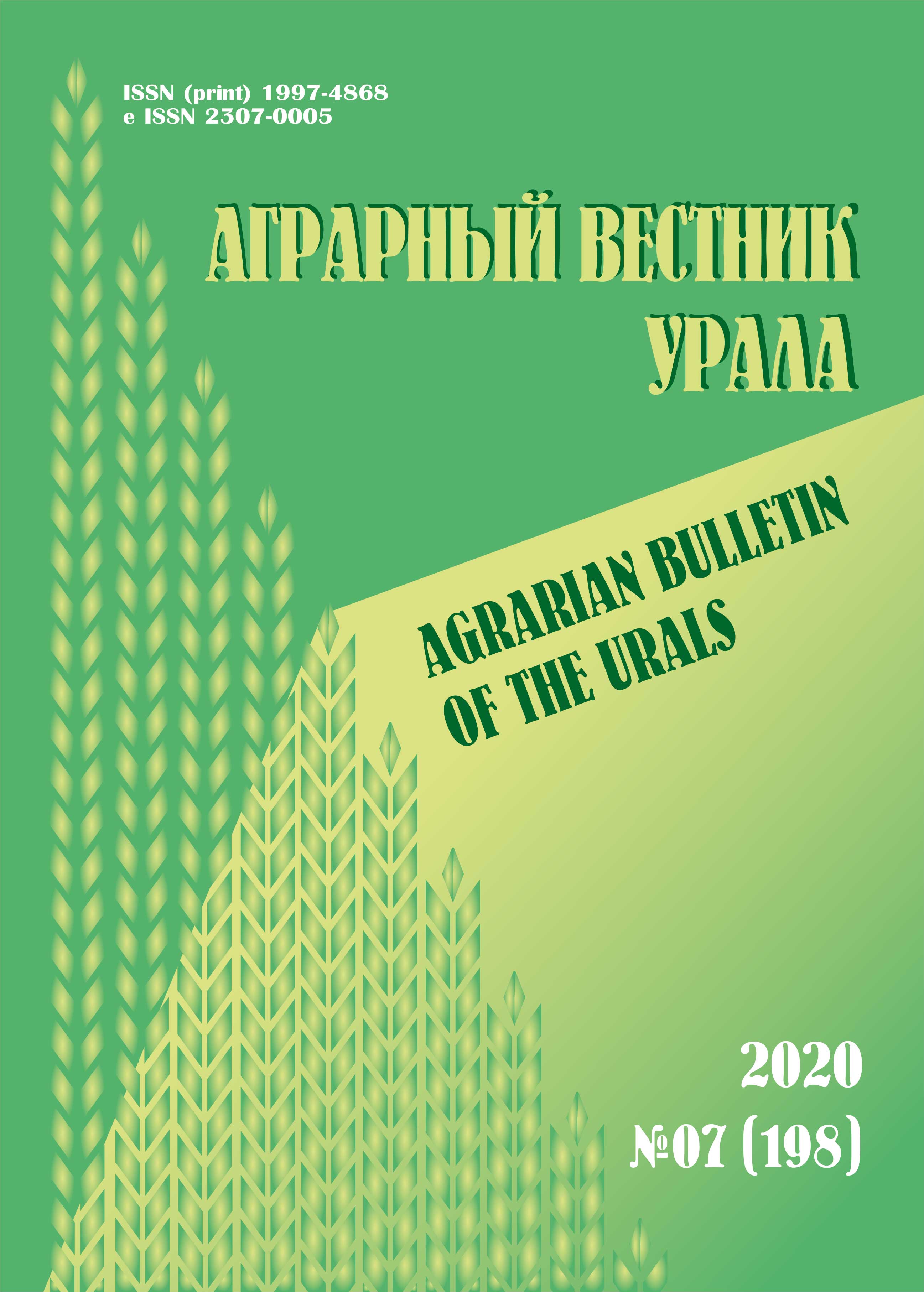Ustye, Belarus
Abstract. The yield potential of seeds of linseed varieties in the Republic of Belarus reaches 30 centners per hectare, in recent years, ten new domestic varieties of crops have been created, and the soil and climatic conditions of the country make it possible to cultivate it. However, when testing varieties in the State Institution “State Inspectorate for Testing and Protection of Plant Varieties”, the values of the seed productivity indicator vary greatly both by test sites and by varieties. In this regard, the aim of the research is to assess the level of productivity and adaptive potential of oil flax varieties by statistical parameters calculated on the basis of “seed productivity”. Methods. Statistical processing of data obtained during four years of testing (2018–2020) was carried out at seven variety plots. As the object of the research, the flax varieties Salyut, Al’yans and Vizir’ of the selection of RUE “Institute of Flax” were taken. An assessment of the studied varieties is given in terms of such parameters as plasticity and stability, indicators of variety stability, yield range, standard deviation, coefficient of variation, homeostaticity and breeding value. Results. The highest seed productivity (13.5–17.2 c/ha) and the smallest variability of the “coefficient of variation” (7.4–18.3 %) were observed in the varieties Salyut and Vizir’. It was found that the variability of the productivity of the studied varieties is caused by the influence of environmental conditions, and not by their genetic characteristics. The stability of obtaining high yields in optimal conditions is evidenced by the obtained values of the adaptability coefficient (0.91–1.06). Thus, with a combination of various statistical indicators and models, an objective and complete characteristic of the studied varieties is given. The data obtained testifies to the prospects of cultivating the varieties of linseed Al’yans, Vizir’, Salyut in agricultural organizations of the republic and the possibility of obtaining high and stable yields of this crop. The scientific novelty of the research lies in the fact that for the first time the characteristics of linseed varieties Alliance, Vizir, Salyut of Belarusian selection in terms of productivity and adaptive potential are given on the basis of a combination of various statistical indicators and models. The data obtained allowed us to make a conclusion about the prospects of cultivating these varieties in the conditions of Belarus.
linseed, variety, seed yield, yield range, adaptive potential, plasticity, stability, coefficient of variation, homeostaticity, breeding value
1. Ivaschenko V. G., Pavlyushkin V. A. Intensifikaciya rastenievodstva i ekologo-produkcionnyy balans agroekosistem: snizhenie plodorodiya pochv i fitosanitarnaya destabilizaciya // Vestnik zaschity rasteniy 2017. № 3 (93). S. 5-16. EDN: https://elibrary.ru/ZIFWHH
2. Kartamysheva E. V., Gorbachenko O. F., Luchkina T. N., Kondaurova V. E. Prodovol'stvennaya bezopasnost' proizvodstva maslichnyh kul'tur // Tavricheskiy vestnik agrarnoy nauki. 2017. № 4 (12). S. 63-70. EDN: https://elibrary.ru/ZXHPSB
3. Navdeep K., Satish P. Correlation and Path Coefficient Analysis for Seed Yield and Fibre Traits in Linseed (Linum usitatissimum L.) // International Journal of Current Microbiology and Applied Sciences. 2020. Vol. 9. No. 02. Pp. 66-75.
4. FAOSTAT [e-resource]. URL: http://www.fao.org/faostat/en/#data/QCL (date of reference: 30.07.2021).
5. Čeh B., Štraus S., Hladnik A., Kušar A. Impact of Linseed Variety, Location and Production Year on Seed Yield, Oil Content and Its Composition // Agronomy. 2020. Vol. 10. No. 11. Article nimber 1770.
6. Kiryluk A., Kostecka J. Pro-Environmental and Health-Promoting Grounds for Restitution of Flax (Linum usitatissimum L.) Cultivation // Journal of Ecological Engineering. 2020. Vol. 21. No. 7. Pp. 99-107.
7. Maslinskaya M. E. Vliyanie meteorologicheskih usloviy Belarusi na osnovnye hozyaystvenno-cennye priznaki l'na maslichnogo // Zemledelie i selekciya v Belarusi: sbornik nauchnyh trudov. Minsk, 2021. № 57. S. 469-476.
8. Andronik E. L., Maslinskaya M. E., Ivanova E. V. Dostizheniya v selekcii l'na maslichnogo v Respublike Belarus' // Agrarnyy vestnik Yugo-Vostoka. 2016. № 1-2 (14-15). S. 53-54. EDN: https://elibrary.ru/WMUEUL
9. Mischenko L. Osobennosti vyraschivaniya l'na maslichnogo [Elektronnyy resurs]. URL http://www.oilbranch.com/publ/view/48.html (data obrascheniya: 22.07.2021).
10. Navdeep K., Satish P. Selection criteria of linseed genotypes for seed yield traits through correlation, path coefficient and principal component analysis // The Journal of Animal & Plant Sciences. 2016. Vol. 26. No. 6. Pp. 1688-1695.
11. Dabalo D. Y., Singh C. S., Weyessa B. Genetic Variability and Association of Characters in Linseed (Linum usitatissimum L.) Plant Grown in Central Ethiopia Region // Saudi Journal of Biological Sciences. 2020. Vol. 27. Pp. 2192-2206.
12. Tavarini S., Castagns A., Conte G., Foschi L., Sanmartin C., Incrocci L., Ranieri A., Serra A., Angelini L. G. Evaluation of Chemical Composition of Two Linseed Varieties as Sources of Health-Beneficial Substances // Molecules. 2019. No. 24. Article number 3729.
13. Thakur R., Paul S., Thakur G., Kumar A., Dogra R. Assessment of genetic diversity among linseed (Linum usitatissimum L.) germplasm based on morphological traits. Journal of Pharmacognosy and Phytochemistry. 2021. Vol. 9. No. 6. Pp. 1785-1790.
14. Porhuncova O. A., Yarohovich M. V. Ishodnyy material dlya selekcii l'na maslichnogo. // Tehnologicheskie aspekty vozdelyvaniya sel'skohozyaystvennyh kul'tur: sbornik statey po materialam VIII Mezhdunarodnoy nauchno-prakticheskoy konferencii. Gorki, 2016. S. 95-98. EDN: https://elibrary.ru/SLMEQO
15. Nehvedovich S. I., Voytka D. V. Fitopatologicheskaya situacii v posevah l'na maslichnogo v usloviyah Respubliki Belarus' i ocenka vredonosnosti dominiruyuschih bolezney // Zemledelie i rastenievodstvo. 2020. № 56. S. 66-74.
16. Golub I. A., Maslinskaya M. E., Savel'ev N. S. Rezul'taty nauchnoy deyatel'nosti i perspektivy razvitiya RUP «Institut l'na» // Nauka - proizvodstvu: dostizheniya i prioritety razvitiya zemledel'cheskoy nauki Belarusi. Prilozhenie k zhurnalu «Zemledelie i rastenievodstvo. 2021. № 3 (136). S. 31-33.
17. Gosudarstvennyy reestr sortov. Minsk, 2021. 279 s.
18. Gosudarstvennyy reestr selekcionnyh dostizheniy, dopuschennyh k ispol'zovaniyu. T. 1. «Sorta rasteniy» (oficial'noe izdanie). Moskva: Rosinformagroteh, 2021. 719 s.
19. Dospehov B. A. Metodika polevogo opyta (s osnovami statisticheskoy obrabotki rezul'tatov issledovaniy): uchebnik dlya studentov vysshih sel'skohozyaystvennyh uchebnyh zavedeniy po agronomicheskim special'nostyam. Moskva: Al'yans, 2011. 350 s.
20. Zykin V. A., Belan I. A., Roseev V. M. Selekciya yarovoy pshenicy na adaptivnost': rezul'taty i perspektivy // Doklady RASHN. 2000. № 2. S. 5-7.
21. Nettevich E. D., Morgunov A. I., Maksimenko M. I. Povyshenie effektivnosti obora yarovoy pshenicy na stabil'nost', urozhaynost' i kachestvo zerna // Vestnik sel'skohozyaystvennoy nauki. 1985. № 1. S. 66-73.
22. Hangil'din V. V., Litvinenko N. A. Gomeostatichnost' i adaptivnost' sortov ozimoy pshenicy // Nauchno-tehnicheskiy byulleten' VSGI. Odessa, 1981. S. 8-14.
23. Zhivotkov L. A., Morozova Z. A., Sekutaeva L. I. Metodika povysheniya potencial'noy produktivnosti i adaptivnosti sortov i selekcionnyh form ozimoy pshenicy po pokazatelyu «urozhaynost'» // Selekciya i semenovodstvo. 1994. № 2. S. 3-6.
24. Goncharenko A. A. Ob adaptivnosti i ekologicheskoy ustoychivosti sortov zernovyh kul'tur // Vestnik Rossiyskoy akademii sel'skohozyaystvennyh nauk. 2005. № 5. S. 49-53. EDN: https://elibrary.ru/HSFQAX










